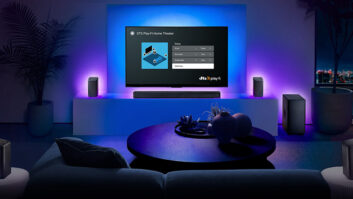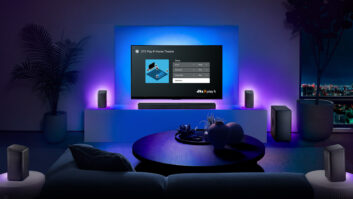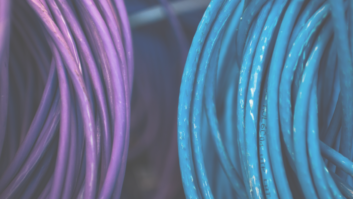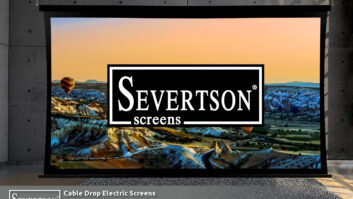With 70 million households subscribing to cable television, making high-definition television programming easily available over cable pipes has long been a benchmark for turning HDTV sets into a mass-market product.
One major stumbling block has been the lack of a standardized, secure connection between digital set-tops and HDTV sets that allows viewers to enjoy high-value content while addressing studios’ concerns over illegal copying and distribution of their product.
The FCC’s ratification in September 2003 of plug-and-play rules that set limits on digital copy protection and direct how cable will interface with HDTV sets goes a long way to making HDTV a cable-friendly medium.
One significant requirement of plug and play is that cable operators have to support new cable-ready HDTV sets that don’t require the use of set-top box. These sets, already introduced by Panasonic and planned by several other manufacturers, use a security module known as CableCARD to perform the conditional access functions of a digital set-top. The PCM/CIA-type card will allow viewers to receive both HDTV and standard definition digital programming, including premium services like HBO.
By July 1, 2004, digital cable operators will have to provide a CableCARD to any subscriber who requests one. Most are already readying their plants and ordering product to support CableCARD operation.
Motorola corporate VP Carl McGrath said that all Motorola-based digital systems have a number of CableCARD units on order, enough to achieve a “critical startup mass.”
“The operators have a few cards in hand, and they are ready to go when the Panasonic sets are in the market,” he said.
Although Panasonic is the only manufacturer with a CableLabs-certified cable-ready HDTV set, Motorola has been testing its CableCARD with most set manufacturers. Testing has shown the need for a few minor software tweaks but hasn’t revealed any “major issues,” says McGrath.
He wasn’t ready to disclose CableCARD pricing, other than to say it will be “less than a [HD] set-top,” which wholesale for around $350 to operators.
Deploying CableCARD is more complicated than just ordering security cards and handing them out to customers. Operators have to upgrade parts of their head-end equipment. Providing a CableCARD will also require a cable technician to visit the subscriber’s home to install the card (which involves a telephone call into the operator to activate it) and make sure the HDTV set is working properly.
“The rollout has many more issues than just the CableCARD,” says Lisa Pickelsimer, director of video product development for Cox Communications. “We have to upgrade our video controllers at the head-end, and that requires vendors to develop new software, and they’re working on that steadily. Because we’re installing new technology in the head-end and a new device, and integrating all this with the billing system, we are taking measured steps in rolling this out. We want to make sure we don’t disappoint the customer.”
Cox has ordered CableCARD gear from both Scientific-Atlanta and Motorola and plans to support trials this winter in two markets, one in Pensacola, Fla. and the other in Orange County, Calif.
Comcast will introduce CableCARD in St. Paul, Minn. and Portland, Ore., distributing cards through professional installations. Deployments in additional markets will be based on retail availability of cable-ready HDTV sets and customer demand, said a Comcast spokesman.
In terms of customer cost, the CableCARD will be treated the same way as a digital cable box. While charges vary by market, Comcast’s cheapest digital cable package is $9.95 per month on top of a basic cable subscription, and includes digital tier networks from Discovery and MTV; a $14.95 per month package adds premium movie channels from Encore. A basic subscriber who only wants local broadcast channels in HDTV could probably lease a CableCARD for around $5 per month.
Smaller operators are also getting ready. Buckeye CableSystem, a 155,000-subscriber system in Ohio, expects to begin providing CableCARD this month after Motorola upgrades its headend gear. Joseph Jensen, Chief Technical Officer for Buckeye, says that customer service reps already have a telephone script in place for CableCARD requests.
Jensen expects each CableCARD will cost Buckeye between $30 and $90, though pricing will be “time- and volume-dependent.” Subscribers will be charged a small installation fee and monthly lease fee, as they would for a set-top converter.
While meeting plug-and-play requirements is the responsibility of each individual operator, the NCTA, CableLabs and CTAM have worked together on implementation issues. CableLabs has tested and approved HDTV sets from Panasonic and CableCARD technology from Motorola, Scientific-Atlanta and NDS. CTAM has developed customer communications and training materials for customer service representatives and shared marketing information with CE manufacturers.
“I think the big challenge here is there are so many players,” says Seth Morrison, senior marketing VP for CTAM. “The fact is that the CE people do the actual [marketing] material, then the retailer gets it and puts their spin on it, and ultimately the customer calls their cable company. These areas all need to work together for the customer to understand what they’re getting and what they’re not getting.”
The major limitation of current CableCARD devices is that they only support one-way operation and can’t yet perform two-way applications like impulse pay-per-view, VOD or operator-enhanced electronic program guides. For those applications subscribers still need a set-top. Since most HDTV set-tops deployed to this date have only analog component video connections, the plug-and-play rules provide for HDTV set-tops with the necessary digital connections to interface with new HDTV sets.
Starting April 1, 2004, cable operators will need to provide HDTV set-tops with “Firewire” (IEEE 1394) connections to subscribers who request them. By July 1, 2005, HDTV set-tops will also require a digital visual interface (DVI) or high-definition multimedia interface (HDMI).
Motorola’s latest HDTV set-top comes standard with what McGrath calls the “Powell package,” i.e. both DVI and Firewire connections. Those connections were options on previous boxes, and most operators didn’t take them.
“A few took DVI, but virtually all of the deployments have been Y/Pr/Pb component,” said McGrath. “That was the common spot for most of the popular monitors, but now you’re seeing more DVI in the marketplace.”
Of course, providing two-way functionality in cable-ready HDTV sets would eliminate the need for set-tops altogether. Cox’s Pickelsimer and Buckeye’s Jensen are both eager for the two-way devices proposed by CE manufacturers and cable operators.
“I don’t think the one-way card is a long-term viable solution,” said Jensen.
Cox’s Pickelsimer is “very excited” about the possibilities of two-way HD devices, but said “getting the technology developed is the most challenging piece.”
One big challenge is being able to upgrade software applications on the two-way sets, something operators take for granted with digital set-tops. The cable industry is working with CE manufacturers to define a standard “middleware” layer that operators could write applications to. Since a two-way system involves sending commands back to headends, there are also network security concerns that need to be addressed.
After reaching a working agreement on plug-and-play in December 2002, cable operators and CE manufacturers began working on an agreement for two-way cable-ready devices last January, says NCTA General Counsel Neal Goldberg. But they soon faced multiple requests from the FCC to clear up outstanding issues on the one-way agreement. After spending most of 2003 making sure the one-way agreement passed FCC muster, the industry groups began meeting again in November to discuss two-way devices.
“We want to get it done as soon as possible,” says Goldberg. “A lot of the reason why we had to deal with one-way so diligently is that without a one-way foundation, we couldn’t do anything on two-way.”













